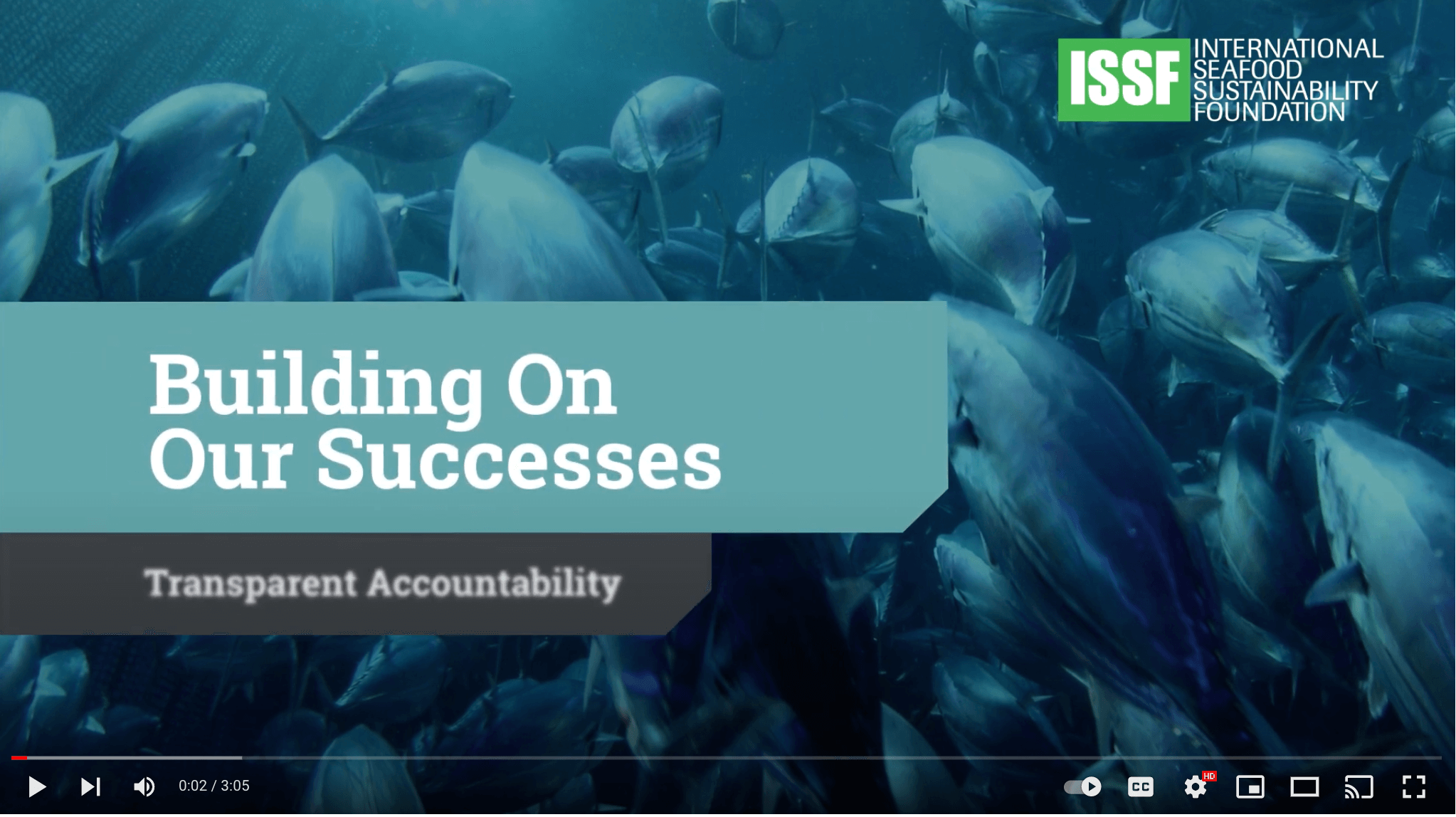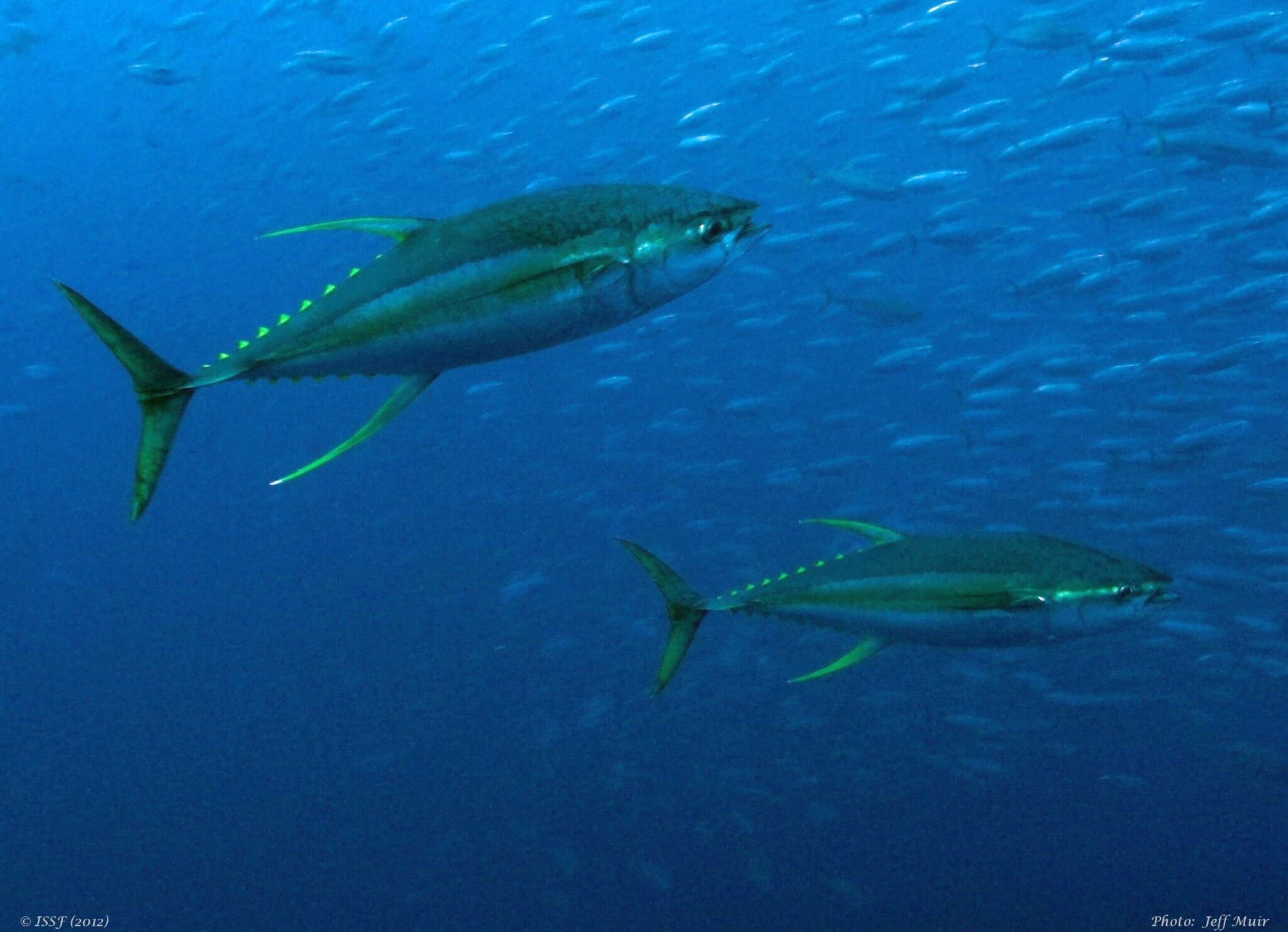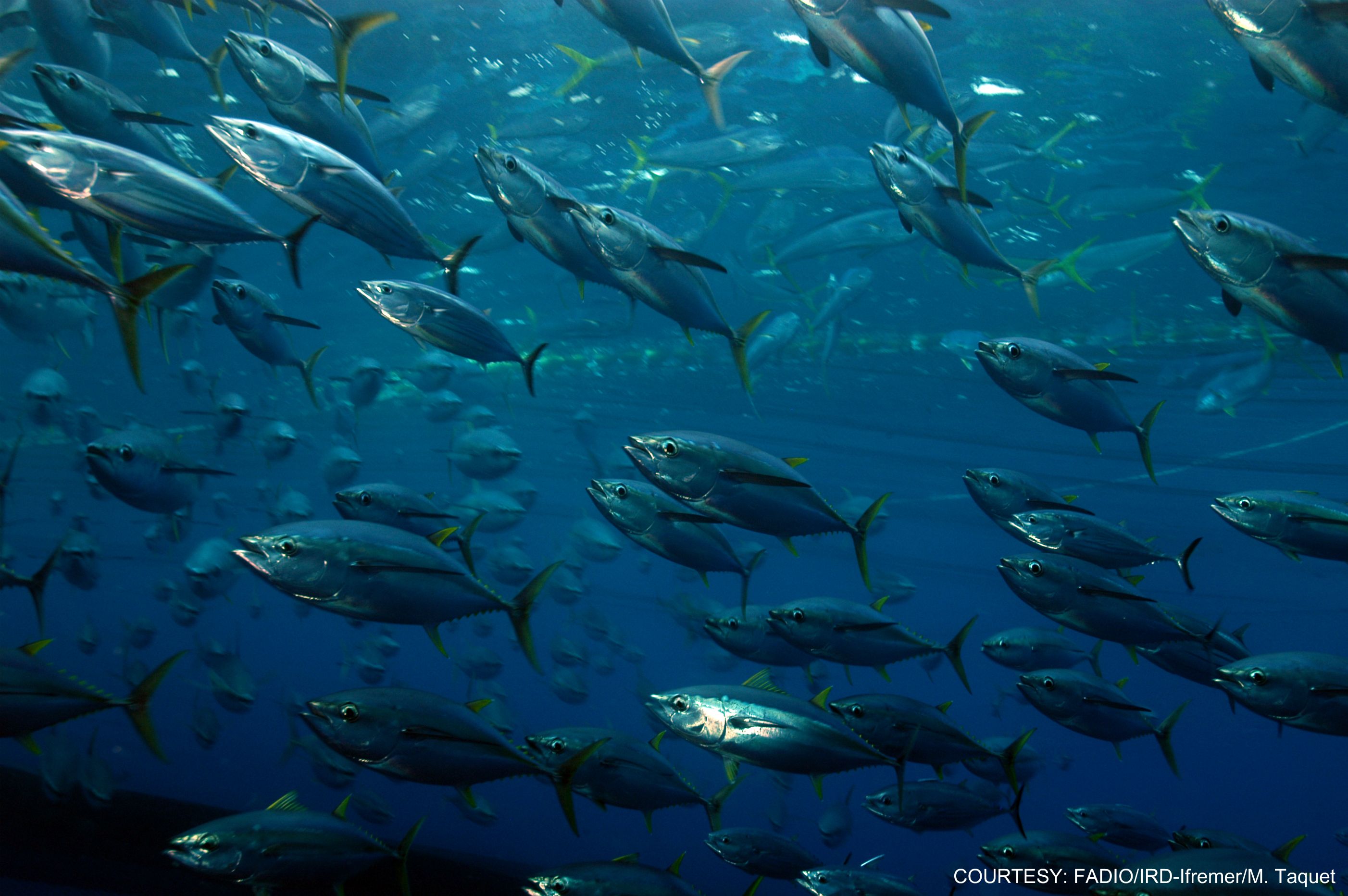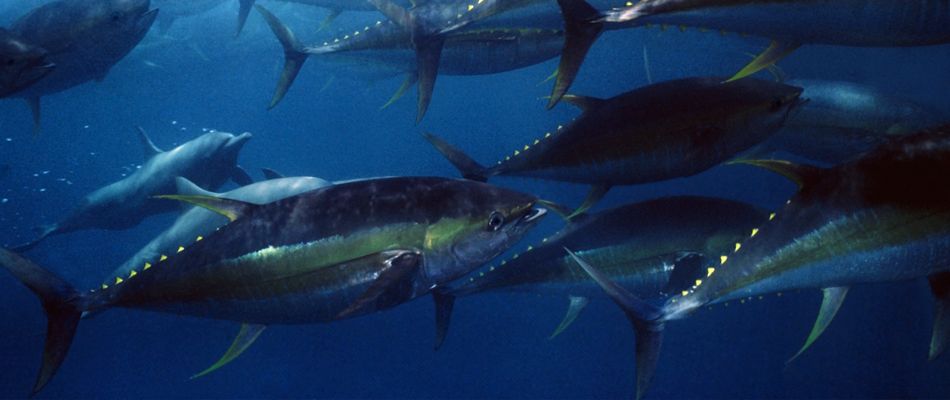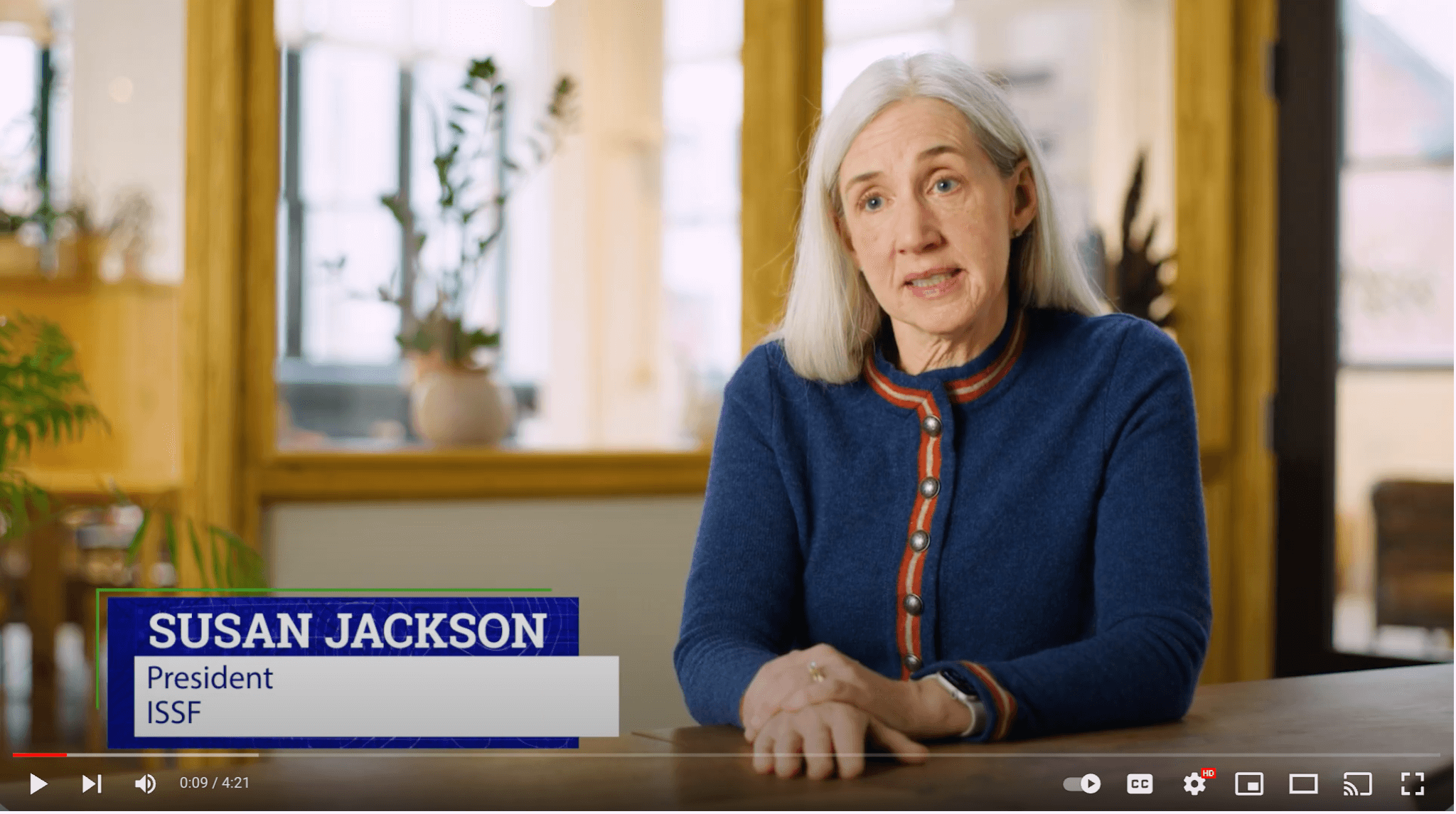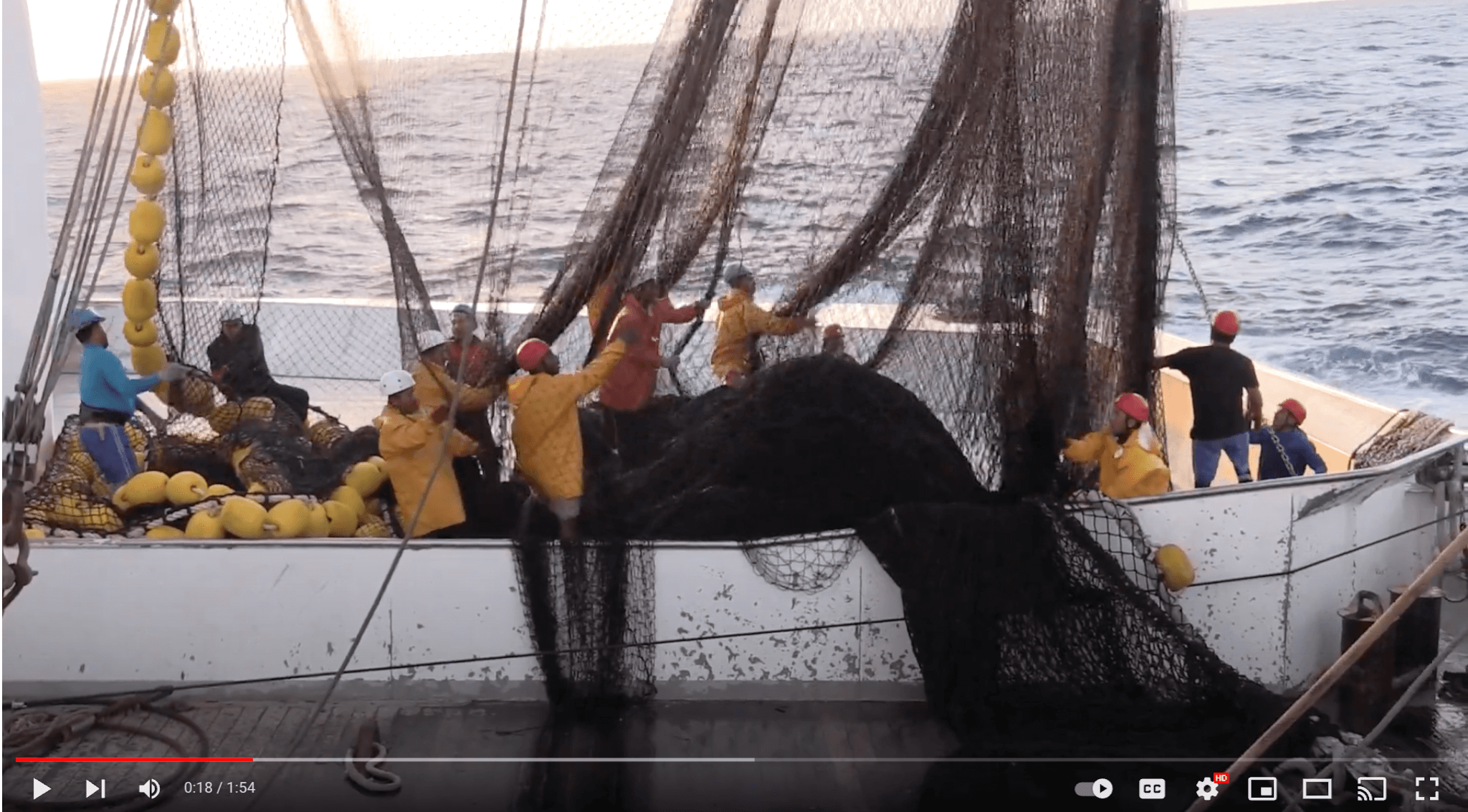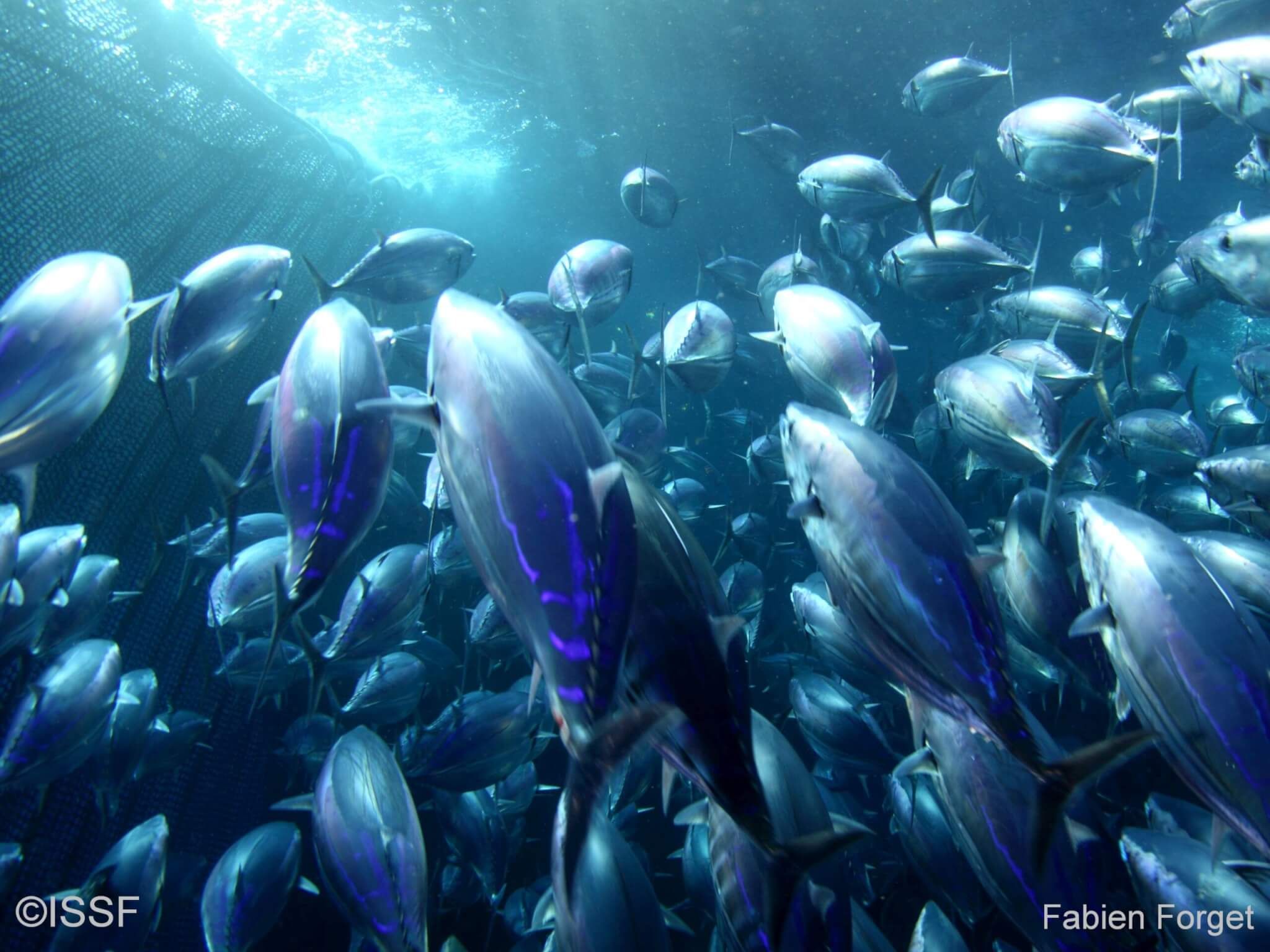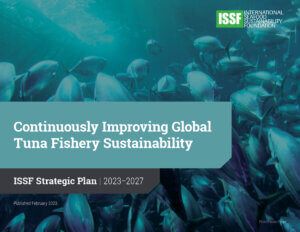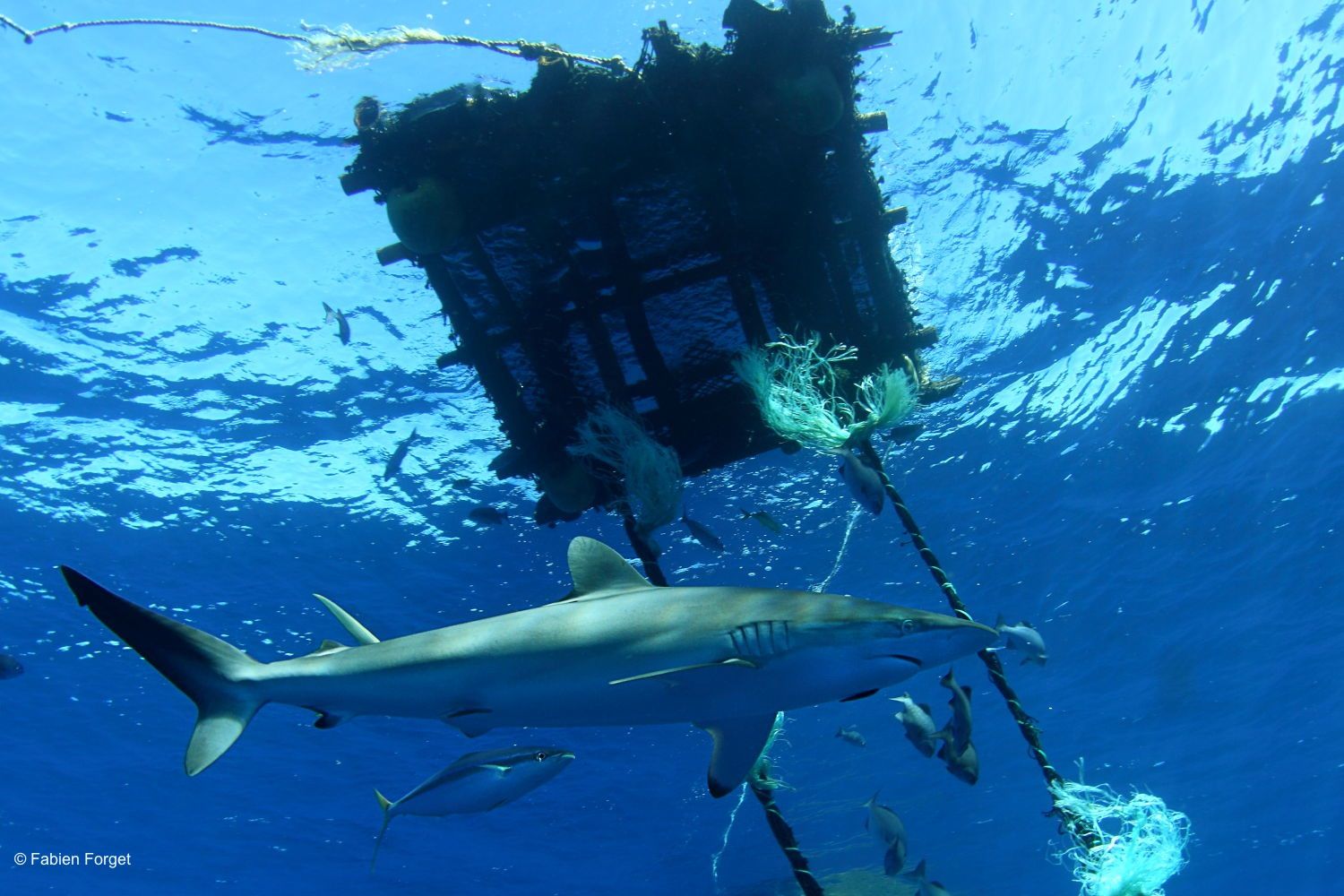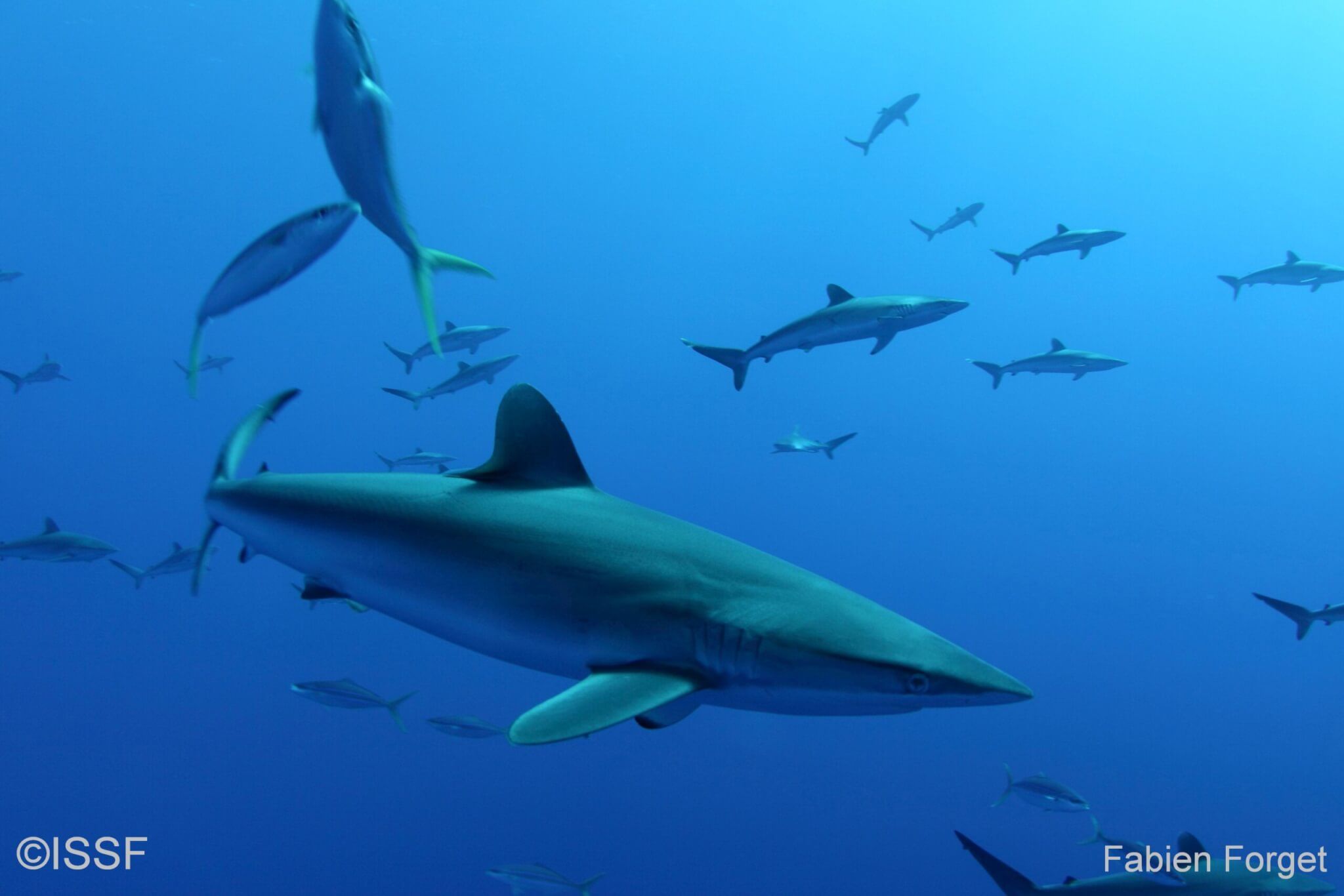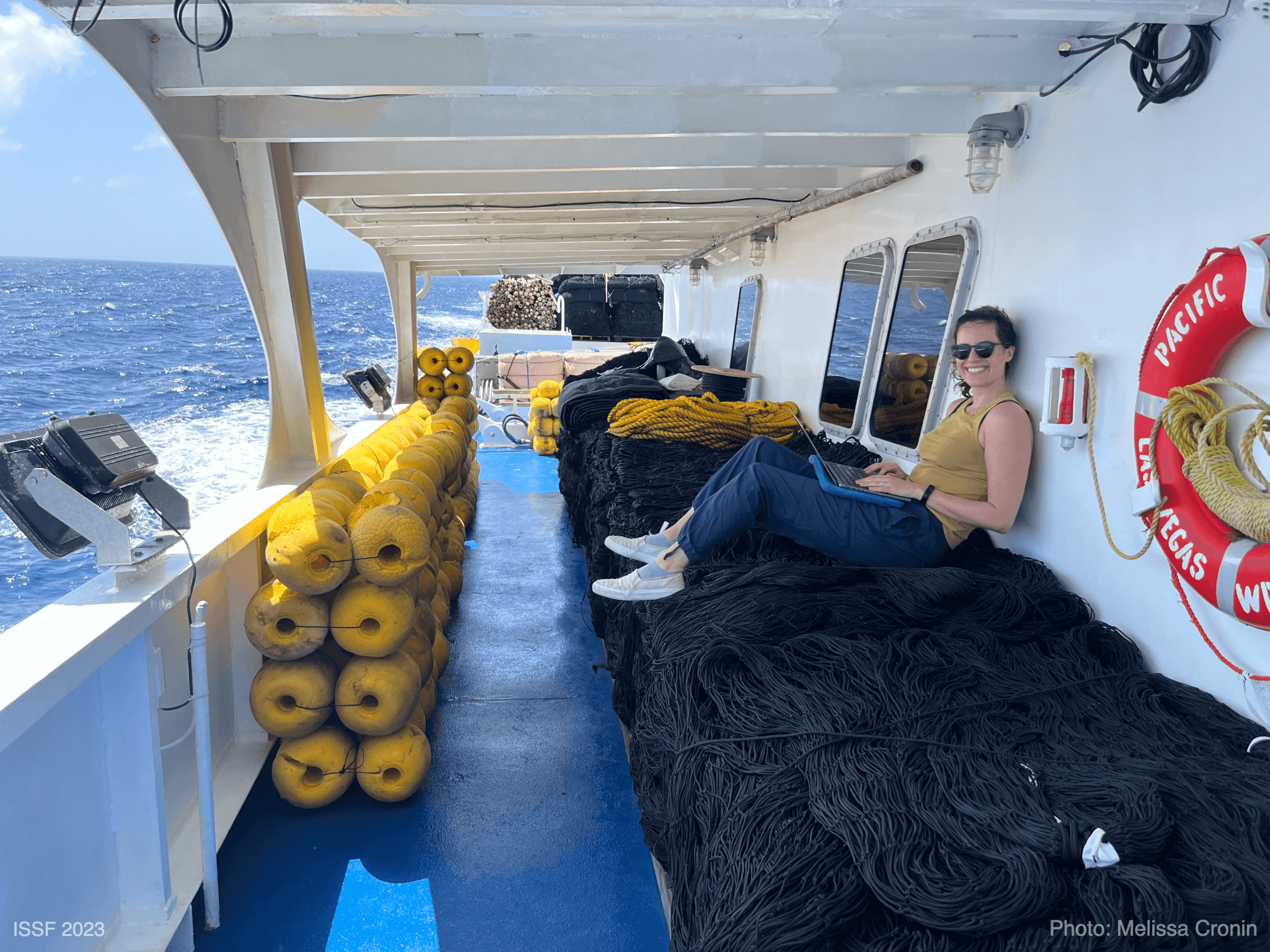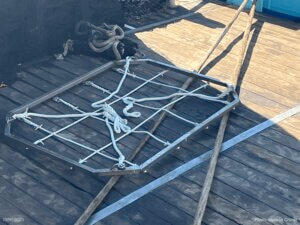Author: svanouse
ISSF Adds “Tuna Catch Trends by Gear Type” Data to Interactive Stock Status Tool
The International Seafood Sustainability Foundation (ISSF) has expanded its “Stock Status Tool” to include an additional category of critical data — tuna catch trends since 1950 by purse seine, pole-and-line, longline, gillnet, and other gear types.
“Credible transparency and accountability across global tuna fisheries is made possible through gathering, disseminating, analyzing, and activating data that is both science-based and attainable,” said ISSF President Susan Jackson. “As a science-first organization, we are committed to making ISSF’s technical content — especially legacy publications like the Status of the Stocks report — and the research supporting it increasingly accessible and available in user-friendly formats. We are pleased to announce the expansion of this essential tool.”
Explore a new dataset in our stock-status tool: tuna catch trends since 1950 by gear type. Share on XThe tool debuted in 2018 with two data-tracking and visualization capabilities: tuna-stock health status since 2011, and current catch share across stocks. It is publicly accessible and does not require additional applications to use.
Located on ISSF’s Website and built using Tableau technology, the “Interactive Stock Status and Catch Tool” is based on ISSF’s semi-annual “Status of the Stocks” report, which compiles data from the science bodies at tuna Regional Fisheries Management Organizations (RFMOs).
The new “Catch Trends” dataset and tab in the tool allow users to:
- Filter gear-type catch data by tuna species, stock area, and year range
- See data as actual catch values in tonnes or scaled to 100%
- Download graphics as images, PDFs, PowerPoint slides, or Tableau workbooks
- Download the raw dataset (CSV format) or the dataset of user-customized graphics (Excel or CSV format)
- Share graphics through email, Twitter, or Facebook via embed code or custom URLs
Sample Use Cases of the Tool
For example, stakeholders interested in analyzing how catch trends by gear type of tropical tuna in the Eastern Pacific Ocean have changed over time, could first select the three tropical tuna species (bigeye, skipjack, yellowfin) and then select Eastern Pacific Ocean as the Stock Area. These data settings provide users with an overview of how catches changed throughout the whole time series (Figure 1).
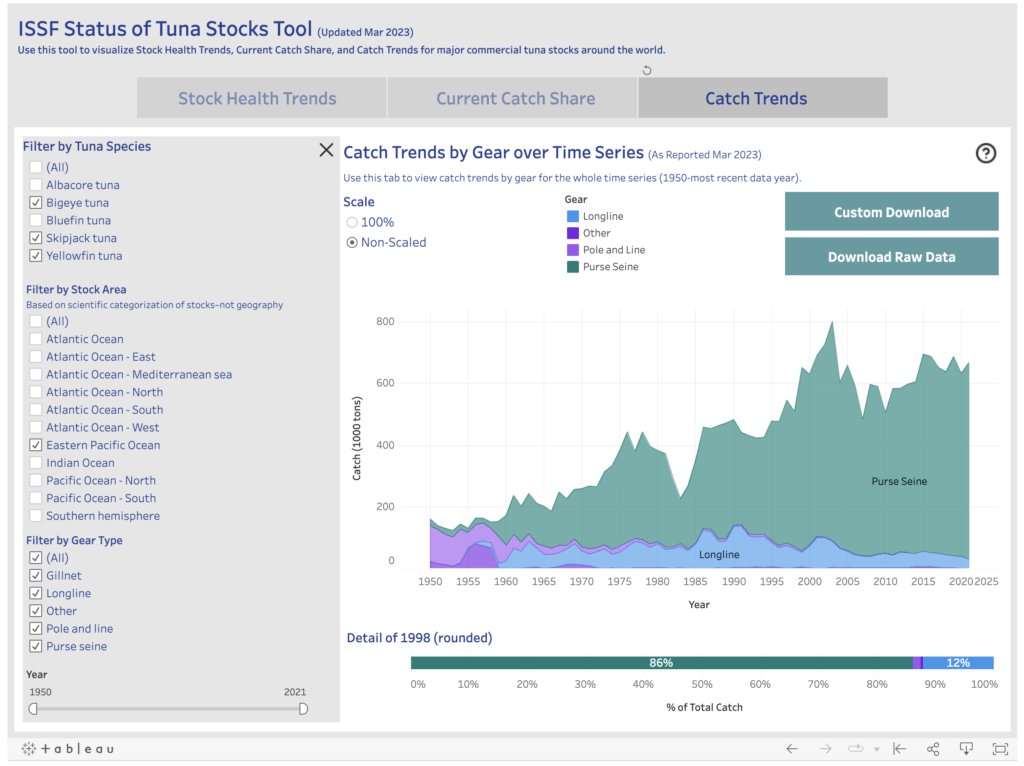
Switching the graph type to “Scaled to 100%” (Figure 2) will help users better visualize the share of catch by gear type in the earlier years, when catches were lower.
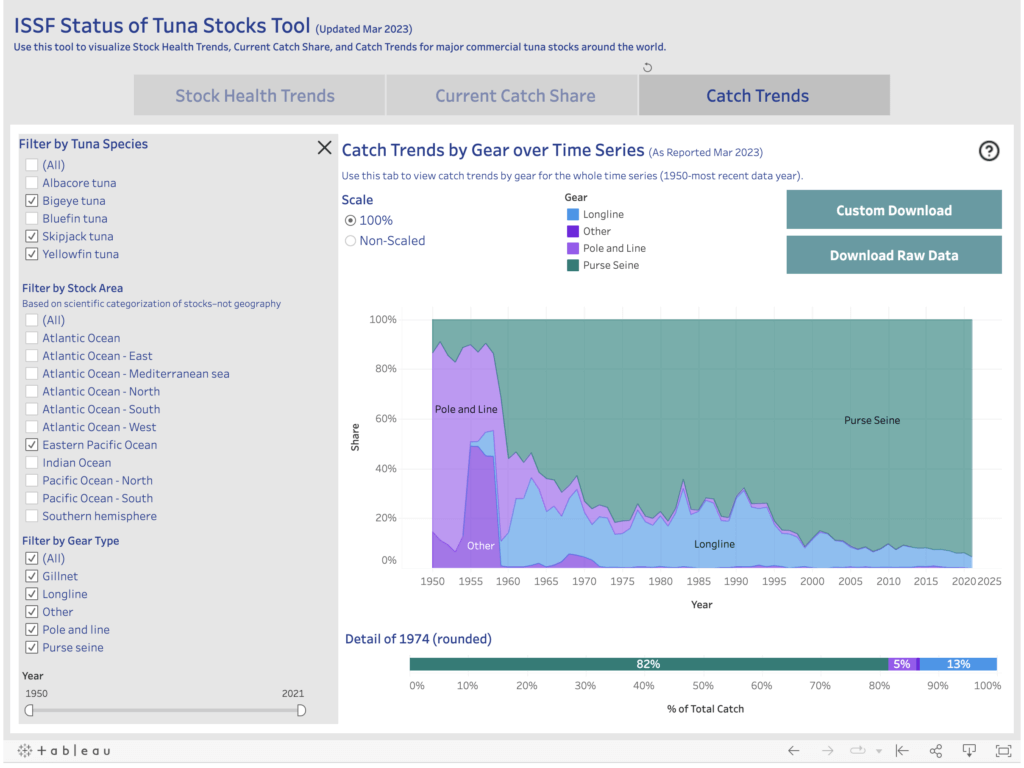
Displaying the data in this way makes it more evident that pole-and-line catches accounted for a high percentage of catches in the 1950s and also that in recent years the highest percentage of the catch has come from purse-seine fisheries.
Users interested in looking at a specific period in more detail can adjust the tool’s “Year” slider to show only the range they are interested in. Following the example above, they could zoom in to 1950-1959 and display data as actual values (i.e. non-scaled) (Figure 3). Doing the same for the last 10 years of the series (2011-2021) paints a clear picture of how catch has changed in terms of total catch (from ~150K tonnes annually to around 650K tonnes) and in terms of share of catch by gear type (from a variety of gears to purse seine being predominant) (Figure 4).
Similarly, stakeholders studying the impact of RFMO stock management decisions can consult the tool to see how catches have increased or decreased during certain time frames — or how catches are trending during stock rebuilding periods.
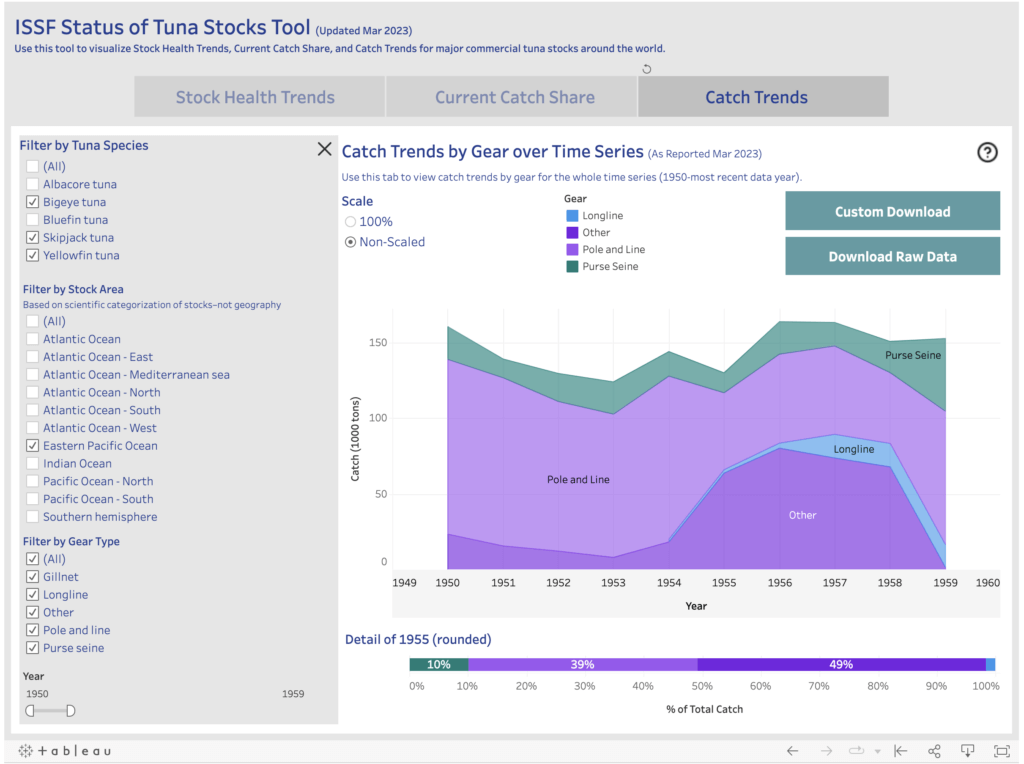
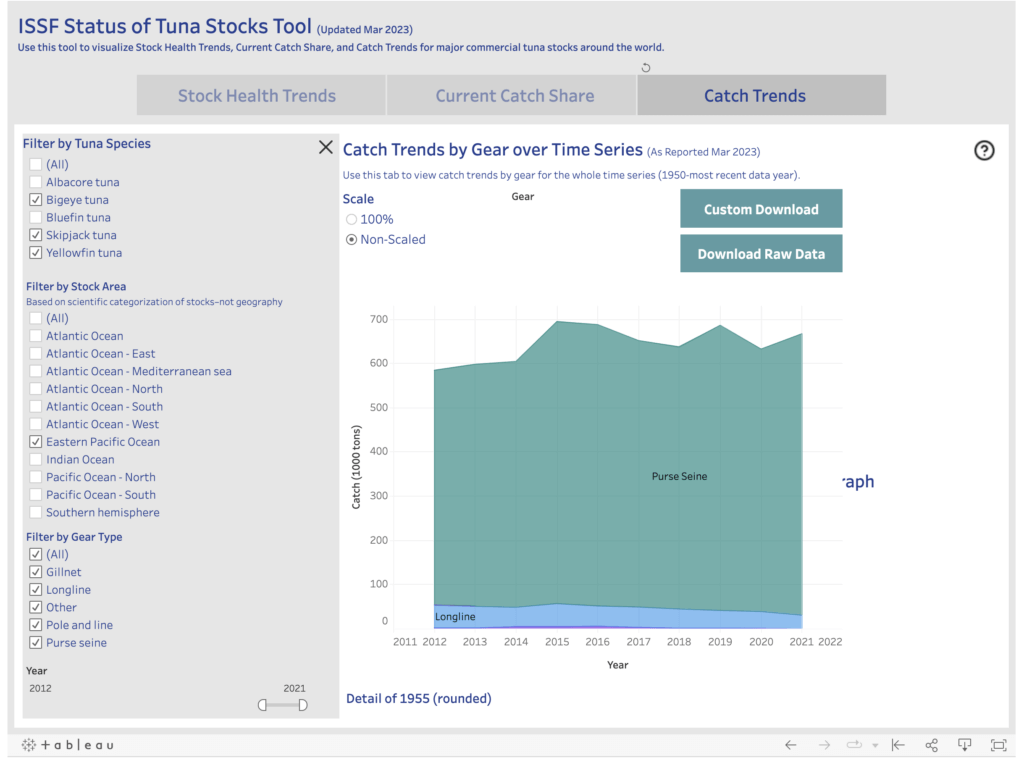
About the Status of the Stocks Report
There are 23 stocks of major commercial tuna species worldwide — 6 albacore, 4 bigeye, 4 bluefin, 5 skipjack, and 4 yellowfin stocks. The Status of the Stocks summarizes the results of the most recent scientific assessments of these stocks, as well as the current management measures adopted by the RFMOs. Status of the Stocks assigns color ratings (green, yellow or orange) using a consistent methodology based on three factors: Abundance, Exploitation/Management (fishing mortality), and Environmental Impact (bycatch).
ISSF produces several Status of the Stocks reports each year to provide clarity about where we stand — and how much more needs to be done — to ensure the long-term sustainability of tuna stocks. The Status of the Stocks presents a comprehensive analysis of tuna stocks by species, and the Evaluation of the Sustainability of Global Tuna Stocks Relative to Marine Stewardship Council (MSC) Criteria provides scores for the stocks and RFMOs based on MSC assessment criteria. Together, these tools help to define the continuous improvement achieved, as well as the areas and issues that require more attention.
ISSF Report: 15 Tuna Stocks Not Meeting Criteria for Marine Stewardship Council (MSC) Fisheries Standard
Fisheries scientists in An Evaluation of the Sustainability of Global Tuna Stocks Relative to Marine Stewardship Council Criteria — a March 2023 report commissioned by the International Seafood Sustainability Foundation (ISSF) — found that eight out of 23 major commercial tuna stocks worldwide are successfully avoiding overfishing and maintaining target stock biomass levels when measured against the Marine Stewardship Council (MSC) Fisheries Standard.
The eight stocks are Western Atlantic skipjack, North Atlantic albacore, South Atlantic albacore, Eastern Atlantic bluefin, Western Pacific skipjack, Eastern Pacific yellowfin, Eastern Pacific skipjack and Indian Ocean skipjack. These stocks achieved a passing score for the Standard’s Principle 1, “Sustainable Fish Stocks,” which requires fisheries to be conducted in a manner that does not lead to overfishing or depletion of exploited populations. Six of those stocks also have fully implemented well-defined harvest control rules. However, failure to implement controls before rebuilding is required has led to an increasing number of stocks failing to meet minimum requirements on harvest control rules.
Our new report finds that overfishing is being avoided for 8 of 23 commercial tuna stocks worldwide, when measured against the @MSC_ecolabel Fisheries Standard. Share on XUnder the Standard’s Principle 3, “Effective Management,” RFMOs scored well overall, with the four tropical tuna RFMOs receiving passing scores. Most tuna RFMOs exhibited similar weaknesses in compliance and enforcement, while other weaknesses varied between RFMOs.
About the MSC Fisheries Standard
MSC is an independent, international, non-profit organization that oversees a program to assess global wild-capture fisheries and certify them as “sustainable” if they meet its Fisheries Standard criteria. In the previous January 2022 edition of the report, only six stocks passed Principle 1. In this year’s report, two additional stocks received a passing score. Principle 3 evaluations remained unchanged for the most part.
About the Report
An Evaluation of the Sustainability of Global Tuna Stocks Relative to Marine Stewardship Council Sustainability Standard takes a consistent, comprehensive approach to scoring tuna stocks based on certain components of the MSC standard. Updated regularly since it was first published in 2013, and organized by individual tuna stock and tuna RFMO, the report is designed to:
- Provide a basis for comparing stock scores and tuna RFMO scores as assessed by the same experts
- Become a useful source document for future tuna certifications or in the establishment of tuna Fishery Improvement Projects (FIPs)
- Prioritize ISSF projects and advocacy efforts against initiatives that will improve fisheries’ low performance indicator scores
The scores in the report focus on stock status (MSC Principle 1) and the international management aspects relevant to RFMOs (part of MSC Principle 3) and are based on publicly available fishery and RFMO data. Each of these Principles is evaluated in relationship to Performance Indicators (PIs) within each Principle. The Evaluation report also includes detailed remarks on each stock, evaluations of the five RFMOs, and comprehensive reference citations.
MSC Principle 1
The MSC Principle 1 states: “A fishery must be conducted in a manner that does not lead to overfishing or depletion of the exploited populations and, for those populations that are depleted, the fishery must be conducted in a manner that demonstrably leads to their recovery.” The authors attribute stocks with failing scores to poor stock status, the lack of well-defined harvest control rules, and/or the lack of effective tools to control harvest. Six of the 23 stocks have fully implemented well-defined harvest control rules, and there has been progress towards this aim by all RFMOs.
Regarding stocks receiving passing scores:
- Among nine tuna stocks in the Atlantic Ocean, four received an overall principle-level passing score: Western skipjack, Northern albacore, Southern albacore, and Eastern bluefin (the only bluefin stock to receive a passing score).
- Among nine tuna stocks in the Pacific Ocean, three received overall principle-level passing scores: Western skipjack, Eastern yellowfin and Eastern skipjack.
- Among four stocks in the Indian Ocean, one received an overall principle-level passing score: skipjack.
Regarding stocks receiving failing scores:
- In the Atlantic, yellowfin, bigeye, Eastern skipjack, Western bluefin, and Mediterranean albacore all received principle-level failing scores.
- In the Pacific, six stocks received overall principle-level failing scores: Western yellowfin, Western bigeye, Eastern bigeye, Northern albacore, Southern albacore, and Pacific bluefin.
- In the Indian Ocean, yellowfin, bigeye and albacore all received overall principle-level failing scores.
- Southern bluefin also received an overall principle-level failing score.
MSC Principle 3
The MSC Principle 3 states: “The fishery is subject to an effective management system that respects local, national, and international laws and standards and incorporates institutional and operational frameworks that require use of the resource to be responsible and sustainable.”
One tuna RFMO — the Inter-American Tropical Tuna Commission (IATTC) — received unconditional passing scores for all seven performance indicators under Principle 3. The other three tropical tuna RFMOs (ICCAT, IOTC and WCPFC) received overall principle-level passing scores from the report’s authors. As in the 2022 report, CCSBT did not receive a passing score under Principle 3.
While the report focuses on tuna stock status and sustainability as well as on RFMO policies, it does not address national or bilateral management systems, or gear- or fleet-specific ecosystem impacts — all of which are also considered within the MSC assessment methodology.
Since 2011, ISSF has been an active stakeholder in MSC tuna fishery assessments and certifications. ISSF’s strategic objective is to develop and implement verifiable, science-based practices, commitments, and international management measures to help all tuna fisheries become capable of meeting and maintaining the MSC certification standard.
An Evaluation of the Sustainability of Global Tuna Stocks Relative to Marine Stewardship Council Sustainability Standard was authored by Paul A. H. Medley and Jo Gascoigne. In October 2022, MSC updated the criteria for its standard in announcing the Fisheries Standard 3.0. The ISSF report does not reflect the updated Standard.
ISSF REPORT: 85% of Global Tuna Catch Comes from Stocks at Healthy Levels; 11% Requires Stronger Management
Of the total commercial tuna catch worldwide, 85% is sourced from stocks at “healthy” levels of abundance, according to the newest International Seafood Sustainability Foundation (ISSF) Status of the Stocks report. In addition, 11% of the total tuna catch came from overfished stocks, and 4% came from stocks at an intermediate level of abundance.
Several tuna stocks are considered overfished and/or subject to overfishing:
- Mediterranean albacore, Indian ocean bigeye and Indian Ocean yellowfin stocks are overfished and subject to overfishing.
- Pacific Ocean bluefin is overfished.
The report notes several changes to stock ratings since the last update in November 2022:
- The Indian Ocean bigeye stock’s biomass rating was downgraded from green to orange since the last report.
- The Indian Ocean albacore stock’s fishing mortality rate was upgraded from orange to green.
In terms of management, key updates since November 2022 are the inclusion of:
- A new Management Procedure adopted by the Western and Central Pacific Fisheries Commission (WCPFC) for Western Pacific Ocean skipjack tuna
- A partial harvest strategy adopted by the WCPFC for North Pacific albacore, in line with the one adopted by IATTC in 2022
- A new Management Procedure adopted by the International Commission for the Conservation of Atlantic Tunas (ICCAT) for Western and Eastern Atlantic Bluefin Tuna
ISSF publishes its signature Status of the Stocks report multiple times each year using the most current scientific data on 23 major commercial tuna stocks.
Key Statistics in the New Report
- Abundance or “spawning biomass” levels: Globally, 61% of the 23 stocks are at healthy levels of abundance (down from 65% in November of 2022), 22% are at an intermediate level, and 17% are overfished.
- Fishing mortality levels: 78% of the 23 stocks are experiencing a well-managed fishing mortality rate, and 13% are experiencing overfishing.
- Total catch: The catch of major commercial tuna stocks was 4.8 million tonnes in 2021. 56% was skipjack tuna, followed by yellowfin (31%), bigeye (8%), and albacore (4%). Bluefin tuna accounted for 1% of the global catch.
- Largest tuna catches by stock: The five largest catches in tonnes, unchanged since the previous report, are Western Pacific Ocean skipjack, Western Pacific Ocean yellowfin, Indian Ocean skipjack, Indian Ocean yellowfin, and Eastern Pacific Ocean skipjack.
- Tuna production by fishing gear: 66% of the catch is made by purse seining, followed by longline (9%), pole-and-line (7%), gillnets (4%), and miscellaneous gears (14%). These percentages have changed only slightly since the previous report.
The Status of the Stocks report is reviewed by the ISSF Scientific Advisory Committee, which provides advice on its content. The report does not advocate any particular seafood purchase decisions.
Changes to Report Content
Certain legacy elements of the Status of the Stocks report have been moved online from the PDF to ensure the report is user friendly while improving the accessibility of information on the ISSF website. Content relocated in this version includes:
- Tuna species descriptions, which have been removed from the report, and are now available on the ISSF website: https://www.iss-foundation.org/tuna-stocks-and-management/tuna-fishing/tuna-species/
- RFMO descriptions, references to ISSF 2017-08, now link to available information on the ISSF website: https://www.iss-foundation.org/tuna-stocks-and-management/fisheries-management/regional-fisheries-management-organizations-rfmos/
- The MSC-certified tuna fisheries list, which has been removed as an Appendix and replaced with a link to the list maintained on the ISSF website: https://www.iss-foundation.org/fishery-goals-and-resources/the-marine-stewardship-council-standard/msc-certified-tuna-fisheries/
Other changes throughout the Status of the Stocks report include a revised “Additional Resources” section and a new catch-by-RFMO-and-rating figure. Additional content updates may continue in future reports.
About the Status of the Stocks Report
There are 23 stocks of major commercial tuna species worldwide — 6 albacore, 4 bigeye, 4 bluefin, 5 skipjack, and 4 yellowfin stocks. The Status of the Stocks summarizes the results of the most recent scientific assessments of these stocks, as well as the current management measures adopted by the RFMOs. Status of the Stocks assigns color ratings (green, yellow or orange) using a consistent methodology based on three factors: Abundance, Exploitation/Management (fishing mortality), and Environmental Impact (bycatch).
ISSF produces several Status of the Stocks reports each year to provide clarity about where we stand — and how much more needs to be done — to ensure the long-term sustainability of tuna stocks. The Status of the Stocks presents a comprehensive analysis of tuna stocks by species, and the Evaluation of the Sustainability of Global Tuna Stocks Relative to Marine Stewardship Council (MSC) Criteria provides scores for the stocks and RFMOs based on MSC assessment criteria. Together, these tools help to define the continuous improvement achieved, as well as the areas and issues that require more attention.
In addition, ISSF maintains a data-visualization tool based on its Status of the Stocks report. The “Interactive Stock Status Tool” is located on the ISSF website and accessible through the Status of the Stocks overview page. Users can easily toggle through tuna abundance and exploitation health indicators by catch or stock, filter by location and species, and see the share of total catch by species/stocks and gear types.
Theory of Change — ISSF’s Strategic Plan for 2023–2027
ISSF President Susan Jackson explains the importance of ISSF’s “Theory of Change” to the organization’s new 5-year strategic plan. The 4-minute video was created for the February 2023 plan launch.
Continuously Improving Global Tuna Fishery Sustainability — ISSF’s Strategic Plan for 2023–2027
In a 2-minute video, ISSF President Susan Jackson highlights ISSF’s Strategic Plan for 2023-2027, which launched February 28, 2023.
ISSF 2023-2027 Strategic Plan: Continuously Improving Global Tuna Fishery Sustainability
The International Seafood Sustainability Foundation (ISSF) released its Strategic Plan for 2023-2027, Continuously Improving Global Tuna Fishery Sustainability, which lays out the research and advocacy organization’s mission and approach to achieving its tuna fisheries sustainability objective across the next five years.
“Through a robust, multi-stakeholder exploration process, we developed Continuously Improving Global Tuna Fishery Sustainability as an evolution of our prior strategic plan,” said ISSF President Susan Jackson. “ISSF’s science-based and collaborative work has driven progressive outcomes in the last five years — from our Vessels in Other Sustainability Initiatives (VOSI) list enabling more transparent vessel operations to the design of jelly-FADs that lessen the environmental impact of fish aggregating devices.
Learn about ISSF's new five-year goal for sustainable fishing in our just-published 2023-2027 Strategic Plan. Share on X
“Continuously Improving Global Tuna Fishery Sustainability allows us to build on such accomplishments, while responding to the current sustainability landscape,” Jackson continued. “Articulating our theory of change and a five-year goal, which emphasize a commitment to continuous improvement, helps us recognize the dynamic nature of the world’s tuna fisheries and the stakeholders who rely on them.”
In the new plan, ISSF’s work continues to be grounded in the core pillars of Science, Verification, and Influence, all of which come together to drive more sustainable fisheries management. The Marine Stewardship Council (MSC) Fisheries Standard also remains central to ISSF’s objective. Continuously Improving Global Tuna Fishery Sustainability includes new and evolved elements, as highlighted below, in support of the ISSF mission.
The ISSF Objective & the MSC Fisheries Standard
ISSF’s objective is to continuously improve the sustainability of global tuna fisheries and the ecosystems that support them to result in those fisheries meeting and maintaining the MSC certification standard. As Continuously Improving Global Tuna Fishery Sustainability explains, ISSF achieves this through the development and implementation of verifiable, science-based practices; measurable commitments; and conservation management measures by participating companies and through advocacy to tuna Regional Fisheries Management Organizations (RFMOs).
“Like our previous Strategic Plan, the objective of Continuously Improving Global Tuna Fishery Sustainability includes the MSC Fisheries Standard. But consistent with the theme of continuous improvement, our new plan now pledges ISSF efforts to help fisheries not only meet but also maintain that standard,” said Jackson.
“The recent release of the new MSC Fisheries Standard 3.0 to meet changing expectations and reflect the latest in sustainability science reminds us that the bar is always rising — so too must our level of responsibility and commitment.”
Sustainable Management Requires Continuous Improvement
The 2023-2027 ISSF Strategic Plan outlines the organization’s Theory of Change for the first time. ISSF is a science-driven organization focused on the continuous improvement of global tuna fishery sustainability and seeks to achieve this by:
- Advancing tuna fisheries science
- Implementing direct industry improvements
- Providing scientific guidance and tools
- Working with, and advocating to, RFMOs
- Partnering with supportive organizations and experts
The Theory further states:
- ISSF advocacy to RFMOs is grounded in what the best current science requires.
- Simultaneously, ISSF continuously works to improve the science.
- The intended result of our efforts is the adoption and implementation of science-based management measures by industry and RFMOs.
- We recognize that comprehensive and sustainable management requires continuous improvement.
ISSF Five-Year Goal
The plan also newly establishes a five-year goal for the organization: By the end of 2027, all tuna fisheries from which ISSF participating companies source can meet and maintain the MSC certification standard, or there is a clear roadmap and timeline in place to meet this standard that is underpinned by the best-available science.
Evolving Other Strategic Elements
Additional updates to plan elements build on the organization’s work to date in key areas. ISSF will continue to support and enable tuna fishery improvement projects (FIPs), for example, in seeking to “expedite the achievement of MSC certification standards across global tuna fisheries.”
And the organization’s strategic pillars have new or refined functional targets that align to the latest developments in tuna sustainability:
- Under Science, a focus on Ecosystem Impacts to advance science-based approaches that address fishing’s broader ecosystem effects
- Under Verification, an increased emphasis on the VOSI to track public sustainable fishing commitments made by vessels beyond measures on the ProActive Vessel Register (PVR)
- Under Influence, a directive to help markets transparently verify implementation of policy and purchasing decisions for enhanced credibility
Introducing the Advisory Committee on Working Conditions for Fishing Vessels
Continuously Improving Global Tuna Fishery Sustainability also continues ISSF’s charge to monitor third-party efforts to (1) develop and implement labor and social standards for tuna fishing activities on a global scale and (2) explore appropriate ways for ISSF and/or participating companies to support and implement these standards.
ISSF is announcing a new Advisory Committee on Working Conditions for Fishing Vessels that will guide the development of an ISSF approach to this effort. The Committee comprises experts in tuna fisheries operations and international labor and social issues, including Mike Kraft, Executive Director, FISH Standard for Crew; Tracy Murai, Assistant Global Director Marine & Fisheries, Thai Union; Yemi Oloruntuyi, Ph.D., Head, Social Policy, Marine Stewardship Council; and Jessica Sparks, Ph.D., Research Assistant Professor, Division of Agriculture, Food and Environment at the Friedman School of Nutrition Science and Policy at Tufts University
Download Continuously Improving Global Tuna Fishery Sustainability.
ISSF on IOTC Special Session
The Indian Ocean Tuna Commission (IOTC) recently concluded a Special Session to adopt a conservation and management measure on fish aggregating devices (FADs) in Indian Ocean tuna fisheries. The Special Session was called last year due to inaction on this topic.
In a position statement issued before the IOTC session, the International Seafood Sustainability Foundation (ISSF) urged enhanced, science-based FAD management provisions. ISSF acknowledges the Commission’s progress in adopting some of the improvements called for in our position, including FAD marking guidelines, a timeline for transition to biodegradable FADs, and access to FAD position data for the IOTC Scientific Committee for science needs.
But ISSF is concerned by the lack of a shared effort by all IOTC delegations in working together toward the realization of scientific advice. The general breakdown of communication and negotiation that was evident at the IOTC Special Session sets an unwelcome precedent for future meetings and, ultimately, the sustainable use of Indian Ocean tuna fisheries.
“IOTC parties are beholden to the United Nations Fish Stocks Agreement, the core provisions of which require cooperation and consultation amongst all coastal States and States fishing on the high seas,” noted ISSF President Susan Jackson. “Both practices are critically important in managing highly migratory fish stocks like tuna, and both practices seemed to have been unfortunately lacking at this meeting.
“We therefore remain cautious in our assessment of the effectiveness of the new FAD measure, especially in helping rebuild the yellowfin tuna stock. And we urge all parties to recommit to working together for the long-term sustainable management of Indian Ocean resources.”
ISSF Urges Indian Ocean Fisheries Managers to Strengthen Fish Aggregating Device (FAD) Management Measure at February 2023 Special Session
The International Seafood Sustainability Foundation (ISSF) has published a position statement ahead of the February 3-5 Indian Ocean Tuna Commission (IOTC) Special Session, the objective of which is to adopt an IOTC conservation and management measure on fish aggregating devices (FADs). The Special Session was called last year due to inaction on this topic.
In its position statement, ISSF calls for a concerted effort in the Indian Ocean to better monitor FAD usage and to support the adoption of science-based, FAD-related management measures. Shark and non-target species bycatch and other ecosystem impacts — such as marine debris and FAD beaching — must also be reduced. Using non-entangling and biodegradable FAD designs is a critical step to achieving that.
We've outlined the FAD management issues that the Indian Ocean Tuna Commission (IOTC) must address at its Special Session on February 3-5. Share on XConsistent with appeals ISSF and our stakeholders issued throughout 2022, the ISSF statement specifies enhanced FAD management provisions, including:
- Developing and implementing science-based limits on FAD deployments and/or FAD sets, consistent with management objectives for tropical tunas.
- Allowing the IOTC Scientific Committee to use submitted FAD tracking data for scientific purposes — data that are currently used only for FAD limit compliance purposes.
- Requiring the use of biodegradable materials in the construction of FADs to minimize the use of synthetic/plastic materials in FAD construction. Establish a timeline for transitioning to 100% biodegradable.
- Developing and adopting FAD marking guidelines, including requiring the marking of the buoy and the FAD structure.
- Developing and adopting FAD tracking and recovery policies that consider utilizing supply vessels in FAD recovery efforts.
- Adopting clearer rules for FAD ownership and activation, as well as for deactivation of FAD buoys.
Read the full IOTC Special Session Position Statement on the ISSF website.
Update from the Field: Fishing for Answers for Endangered Mobulid Rays
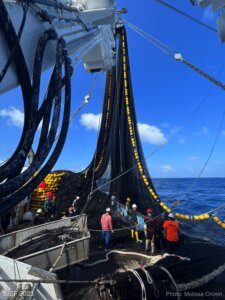 Testing conservation solutions can sometimes require setting sail on the high seas.
Testing conservation solutions can sometimes require setting sail on the high seas.
In December 2022, we began the first of our field expeditions onboard tuna purse seine vessels, in collaboration with the National Oceanic and Atmospheric Administration (NOAA); AZTI; University of California, Santa Cruz; and the American Tunaboat Association.
We’re searching for Mobulids — otherwise known as manta and devil rays — which are sometimes captured accidentally by fishing boats.
Protecting Vulnerable Mobulids
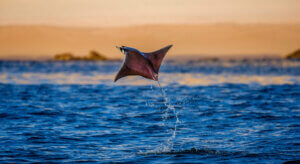
Though these encounters are rare and occur primarily in free-swimming-school sets, it’s important that scientists and fishers work together to avoid these interactions because Mobulids are experiencing population declines globally.
We have two main goals for these trips: first, we want to simply find out more information about these threatened species, using fishing vessels as scientific platforms.
We’re taking tiny samples of Mobulid tails that can be used to unlock huge amounts of genetic and demographic information about these mysterious species.
We’re also swabbing Mobulid mucus that can be used for novel rapid identification technology by the organization iCatch to improve species identification in fisheries across the world.
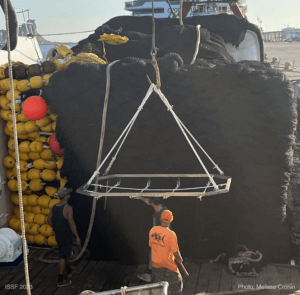 Testing the Manta Grid
Testing the Manta Grid
Second, we are working with fishing crews to test out a novel bycatch mitigation technology — a “manta grid,” designed to facilitate fast release for accidentally captured rays. The grid takes advantage of the powerful hydraulic machines already in place on these vessels — which come in handy when you need to lift a Mobulid that weighs the same as a small car.
Even more important, Mobulids, like many sharks, need to constantly pass water over their gills to stay alive (a process called ram ventilation). So, any technology that brings the animal back into the water faster is likely to increase their chance of survival after release. For Mobulids, who reproduce slowly and have only one offspring every few years, reducing the impact of bycatch could have huge benefits for population status.
But all good technologies need to be tested. To test the manta grid, we are deploying satellite-linked tags on Mobulids captured in the net. These tags not only tell us whether a Mobulid survives the capture.
They also can give us rare and valuable information on the movement of Mobulids. For remote and distant areas of the high seas, this kind of data is virtually impossible to access with conventional scientific methods.
Working with Fishers at Sea
We’ve been at sea onboard the American purse seiner Pacific Princess for three weeks now and are on the lookout for any of the five Mobulid species found in the Pacific Ocean.
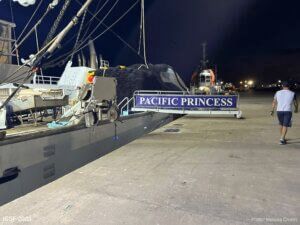
In the meantime, working with tuna fishers at sea presents a unique opportunity to gather information about Mobulid sightings, consult with crew about feasible solutions, and share our Mobulid research and conservation.
Stay tuned for more news from the expedition and results from this project!
Melissa Cronin, Ph.D. of the University of California, Santa Cruz, was the Grand Prize winner in ISSF’s International Seafood Sustainability Foundation (ISSF) Seafood Sustainability Contest.She won for her contest entry, “Incentivizing Collaborative Release to Reduce Elasmobranch Bycatch Mortality,” which proposed handling-and-release methods that purse-seine vessel skippers and crew can use to reduce the mortality of manta rays and devil rays incidentally caught during tuna fishing.
